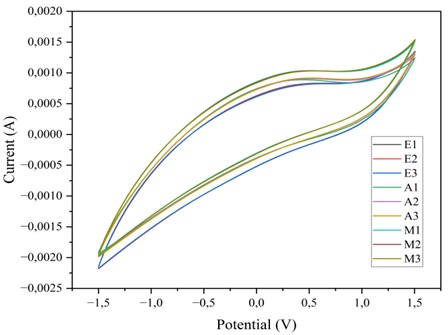The Fabrication of ZnO Nanoparticles-Modified Carbon Paste Electrode for the Analysis of Nicotine Content in E-Cigarette Liquids by Cyclic Voltammetry
Abstract
ZnO nanoparticles were used as composites on carbon paste working electrodes to enhance electrode performance in the analysis of nicotine content in e-cigarette liquids by voltammetry cyclic. The optimum composition and condition (pH and scan rate) were determined to identify the conditions that gave the best response. ZnO nanoparticles were synthesized using the sol-gel method and characterized by FTIR, XRD, and SEM. The determination of optimum composition and conditions was studied using cyclic voltammetry. The determination of nicotine content in e-cigarette liquids was analyzed by cyclic voltammetry. The electrode composition that gave the best response was 3:5:2 (carbon: nanoparticles ZnO: paraffin). The optimum conditions for nicotine determination by cyclic voltammetry were at pH 8 and a scan rate of 90 mVs-1. The cyclic voltammetry’s limit detection (LoD) using a ZnO nanoparticles-modified carbon paste electrode is 0.00678 mg/mL, and the percent recovery is 100.35%.
Downloads

Copyright (c) 2024 Vita Ayu Fatihah, Pirim Setiarso

This work is licensed under a Creative Commons Attribution-NonCommercial-NoDerivatives 4.0 International License.
Authors who publish with this journal agree to the following terms:
- Copyright on any article is retained by the author(s).
- The author grants the journal, the right of first publication with the work simultaneously licensed under a Creative Commons Attribution License that allows others to share the work with an acknowledgment of the work’s authorship and initial publication in this journal.
- Authors are able to enter into separate, additional contractual arrangements for the non-exclusive distribution of the journal’s published version of the work (e.g., post it to an institutional repository or publish it in a book), with an acknowledgment of its initial publication in this journal.
- Authors are permitted and encouraged to post their work online (e.g., in institutional repositories or on their website) prior to and during the submission process, as it can lead to productive exchanges, as well as earlier and greater citation of published work.
- The article and any associated published material is distributed under the Creative Commons Attribution-NonCommercial-NoDerivatives 4.0 International License.





_copy1.png)










